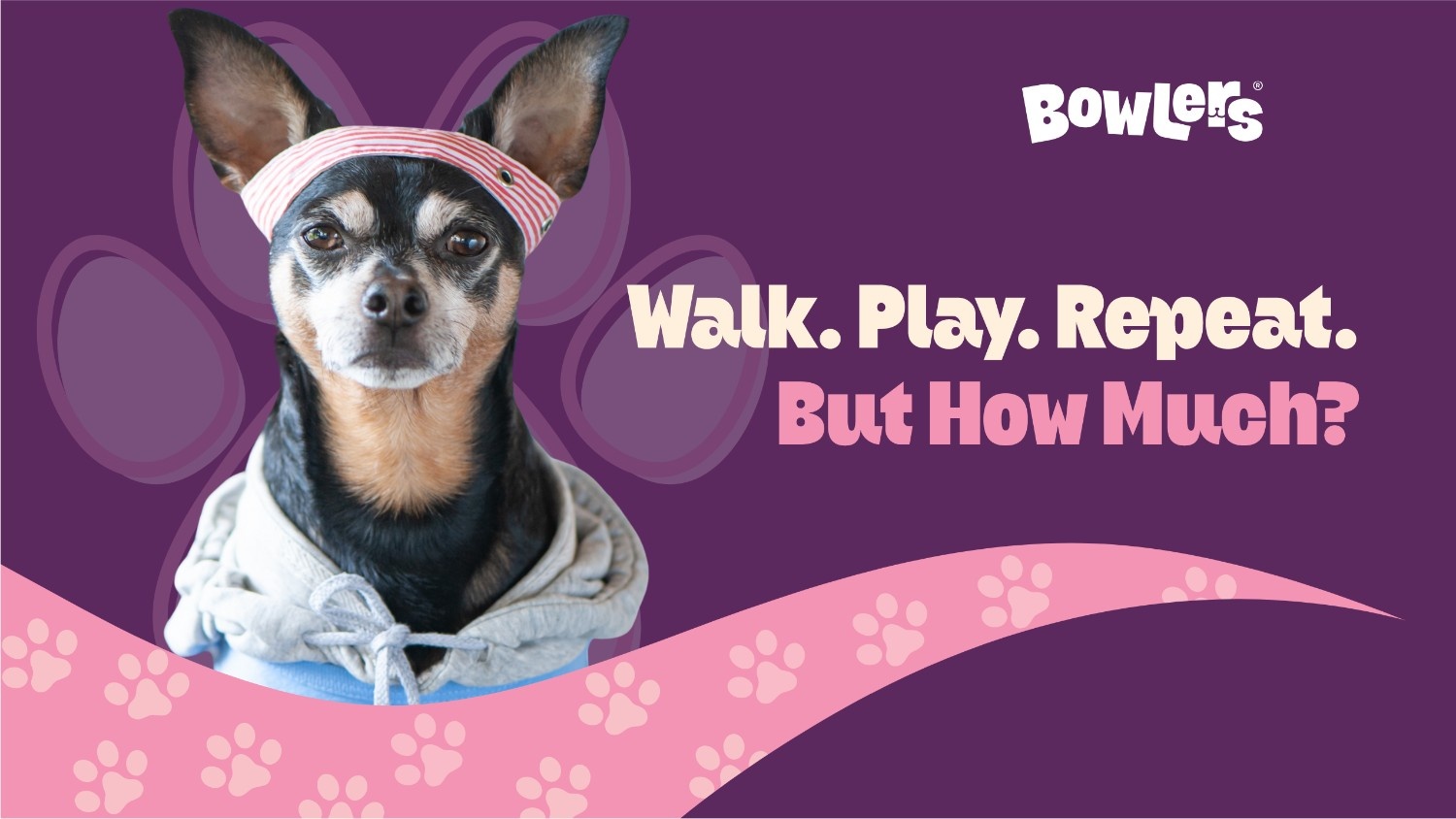How Much Exercise Does Your Dog Really Need?

Exercise is essential to your dog’s overall health, happiness, and longevity. But how much physical activity is enough? Every dog is unique, with different dog exercise needs based on their age, breed, size, and health status. While some dogs thrive on hours of play and vigorous runs, others need only moderate daily walks to stay fit and content.
Understanding your dog’s daily activity for dog requirements helps prevent obesity, behavioral issues, and joint problems, while also improving their mood and energy. At Bowlers, we emphasize that regular exercise is a cornerstone of preventive dog healthcare, supporting everything from muscle strength to cardiovascular health.
In this guide, we’ll explore how to determine the right amount of exercise for your dog, including special considerations for puppies, senior dogs, and high energy breeds. We’ll also share expert dog fitness tips and ideas for cultivating an active dog lifestyle that keeps tails wagging and spirits high.
Why Exercise Matters
Exercise plays a critical role in a dog’s physical and mental well being. Regular activity:
- Helps maintain a healthy weight
- Strengthens muscles and joints
- Supports heart and lung function
- Reduces anxiety and destructive behavior
- Encourages social interaction and bonding
Dogs that don’t receive enough exercise are more prone to obesity, stress related habits like chewing or barking, and chronic diseases such as diabetes and arthritis.
For more ways to keep your dog healthy, explore our guide: How Often Should You Take Your Dog to the Vet? A Complete Guide.
Understanding Dog Exercise Needs by Age and Breed
Puppies: Exercise for Puppies
Young dogs are full of energy, but their bones and joints are still developing. Over-exercising puppies can cause injury or long term problems, so it’s important to strike a balance. Short bursts of play, gentle walks, and supervised interaction are ideal.
- Limit exercise to 5 minutes per month of age, up to twice a day
- Avoid jumping exercises and rough play that could stress growing joints
- Socialization, like playing with other puppies, is as important as physical activity
A structured routine helps build endurance while promoting proper development.
Adult Dogs: Daily Activity for Dogs
Adult dogs are the most adaptable when it comes to exercise. The general recommendation is at least 30 to 60 minutes of physical activity per day, which can include walks, fetch, swimming, or agility training.
- Low energy breeds (like Bulldogs) may need shorter, moderate walks
- High energy breeds (like Border Collies or Labrador Retrievers) may require longer and more intense sessions
- Consistency is key—daily activity helps regulate weight, digestion, and mood
You can break up exercise into shorter sessions throughout the day for variety and mental stimulation.
Senior Dogs: Adjusting Activity as They Age
As dogs grow older, their exercise needs change. Joint pain, arthritis, or decreased stamina may limit their ability to perform high impact activities.
- Focus on gentle walks and stretches
- Incorporate swimming or low impact exercises to reduce stress on joints
- Pay attention to signs of fatigue, soreness, or reluctance to move
Regular but moderate exercise supports mobility and prevents muscle loss.
Dog Fitness Tips for All Breeds
Creating a routine that meets your dog’s individual needs doesn’t have to be complicated. Here are some practical dog fitness tips you can implement today:
- Schedule exercise like a routine appointment – Consistency helps your dog build stamina and look forward to playtime.
- Mix physical activity with mental stimulation – Puzzle toys, scent games, and training drills engage the mind while encouraging movement. Try interactive toys like the Chew Rope, which combines play and exercise to keep your pet both active and mentally engaged.
- Rotate activities – Incorporate walks, games of fetch, or agility exercises to keep things interesting.
- Monitor your dog’s behavior – Watch for signs of fatigue, overheating, or pain, especially in extreme weather.
- Ensure proper nutrition – A balanced diet supports energy levels and muscle function. Learn more in our article on Dog Dental Care 101: Brushing, Chews, and Vet Visits, where dental health is tied to overall wellness.
Signs Your Dog Needs More (or Less) Exercise
Knowing whether your dog’s exercise routine is working is just as important as planning it. Look for the following signs:
Signs You May Need to Increase Activity
- Restlessness or pacing
- Destructive chewing or digging
- Excessive barking
- Weight gain despite regular feeding
- Anxiety or hyperactivity
Signs You May Need to Reduce Activity
- Limping or difficulty walking
- Excessive panting or drooling
- Stiffness after exercise
- Reluctance to move
- Loss of appetite or behavioral changes
If you notice these symptoms, adjusting the exercise plan or consulting your veterinarian can help ensure your dog stays safe and healthy.
For tips on detecting early health issues, see our guide: 8 Signs of a Healthy Dog (and Early Warnings of Trouble).
How to Foster an Active Dog Lifestyle
Encouraging lifelong activity involves more than just physical exercise—it’s about promoting habits that integrate movement into daily life.
- Create opportunities for play—toss balls, use treat puzzles, or explore new environments
- Set walk routes that challenge your dog’s senses—different terrains or parks offer both exercise and mental stimulation
- Offer variety—rotate between indoor and outdoor activities to prevent boredom
- Encourage social play—dog parks, playdates, and group training sessions offer exercise with companionship
An active lifestyle not only keeps your dog fit but also strengthens your bond and improves their overall happiness.
Safety Considerations During Exercise
While exercise is important, safety should never be overlooked. Follow these guidelines to keep your dog healthy while staying active:
- Avoid peak heat hours—exercise early morning or evening in warmer climates
- Stay hydrated—carry fresh water and offer frequent breaks
- Use proper gear—leashes, harnesses, or protective footwear may be necessary for certain breeds or activities
- Watch for signs of overheating or exhaustion, especially in older dogs or breeds with short snouts
Combining safety with routine exercise ensures that your dog stays healthy without unnecessary risks.
Meeting your dog’s exercise needs is one of the simplest yet most impactful ways to promote their long term health. Whether you’re caring for a puppy, an active adult, or a senior dog, tailoring their daily activity for dogs ensures that they stay fit, happy, and free from disease.
By incorporating structured exercise routines, staying mindful of your dog’s limits, and offering a variety of activities, you can create an active dog lifestyle that supports both body and mind. Alongside a nutritious diet, parasite prevention, and regular vet visits, exercise plays a key role in comprehensive preventive dog healthcare.


